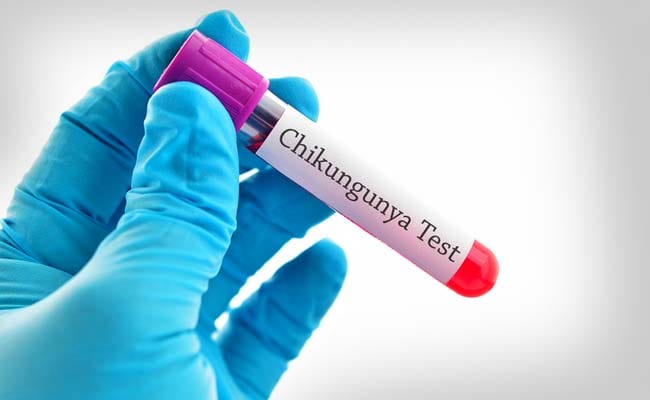
At least 15 deaths due to complications triggered by the current strain of Chikungunya.
New Delhi:
Doctors at AIIMS have identified the genotype of the chikungunya virus which has afflicted nearly 3,700 people in the national capital this season and concluded it is the same as the one that caused the 2006 outbreak of the vector-borne disease.
"We have identified the genotype of the virus-East Central South African-and sent the report to the National Vector-Borne Disease Control Programme (NVBDCP). It is the same genotype that was in circulation in 2006 outbreak," Lalit Dar of Department of Microbiology at AIIMS told PTI. Chikungunya is generally considered a non-fatal disease. It is caused by the chikungunya virus (CHIKV), which has one serotype only. There are three genotypes of this serotype - Asian, West African and East Central South African.
A genotype is the part (DNA sequence) of the genetic makeup of a cell and serotypes are groups within a single species of microorganisms, such as bacteria or viruses, which share distinctive surface structures.
At least 15 deaths due to complications triggered by the disease have been reported at various hospitals in the city and health experts had earlier conjectured that the virus may have "evolved" this time.
"So, it appears, the high number of cases being reported in Delhi this year are possibly due to people's susceptibility to this disease...(those) who either migrated to Delhi-NCR region or were born after 2006 and thus not exposed to the virus," he said.
Meanwhile, the number of cases of chikungunya continue to rise in the city, with at least 3,695 cases being reported till September 24, according to a report released today by the South Delhi Municipal Corporation which tabulates the data for vector-borne disease cases in the national capital on behalf of all the civic bodies here.
Among the three corporations, SDMC has recorded 389 cases, followed by 370 in areas under the North Delhi Municipal Corporation and 115 under the East Delhi Municipal Corporation.
When asked if the genotype could differ in different geographical regions, Dar said, "India is a big country and in these ten years since the last major outbreak, the situation has changed. So, one doesn't know which genotype is in circulation in south India, though, it possibly is the same as in the north."
He added in 2006, the East Central South African genotyope was in circulation across the country and the study of the virus at least depicts the picture practically for north India.
According to municipal data, the last time the number of affected people had reached three-figure mark in Delhi was in 2011.
In 2006, over 13 lakh suspected cases of chikungunya were reported.
At least 16,918 people have been affected by chikungunya across the country, with 9,808 in Karnataka and 1,024 in Maharashtra, according to NVBDCP.
"We have identified the genotype of the virus-East Central South African-and sent the report to the National Vector-Borne Disease Control Programme (NVBDCP). It is the same genotype that was in circulation in 2006 outbreak," Lalit Dar of Department of Microbiology at AIIMS told PTI. Chikungunya is generally considered a non-fatal disease. It is caused by the chikungunya virus (CHIKV), which has one serotype only. There are three genotypes of this serotype - Asian, West African and East Central South African.
A genotype is the part (DNA sequence) of the genetic makeup of a cell and serotypes are groups within a single species of microorganisms, such as bacteria or viruses, which share distinctive surface structures.
At least 15 deaths due to complications triggered by the disease have been reported at various hospitals in the city and health experts had earlier conjectured that the virus may have "evolved" this time.
"So, it appears, the high number of cases being reported in Delhi this year are possibly due to people's susceptibility to this disease...(those) who either migrated to Delhi-NCR region or were born after 2006 and thus not exposed to the virus," he said.
Meanwhile, the number of cases of chikungunya continue to rise in the city, with at least 3,695 cases being reported till September 24, according to a report released today by the South Delhi Municipal Corporation which tabulates the data for vector-borne disease cases in the national capital on behalf of all the civic bodies here.
Among the three corporations, SDMC has recorded 389 cases, followed by 370 in areas under the North Delhi Municipal Corporation and 115 under the East Delhi Municipal Corporation.
When asked if the genotype could differ in different geographical regions, Dar said, "India is a big country and in these ten years since the last major outbreak, the situation has changed. So, one doesn't know which genotype is in circulation in south India, though, it possibly is the same as in the north."
He added in 2006, the East Central South African genotyope was in circulation across the country and the study of the virus at least depicts the picture practically for north India.
According to municipal data, the last time the number of affected people had reached three-figure mark in Delhi was in 2011.
In 2006, over 13 lakh suspected cases of chikungunya were reported.
At least 16,918 people have been affected by chikungunya across the country, with 9,808 in Karnataka and 1,024 in Maharashtra, according to NVBDCP.
Track Latest News Live on NDTV.com and get news updates from India and around the world

